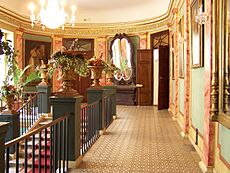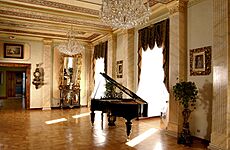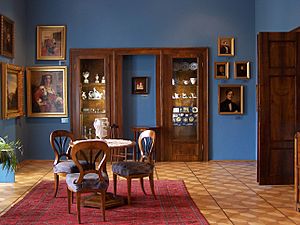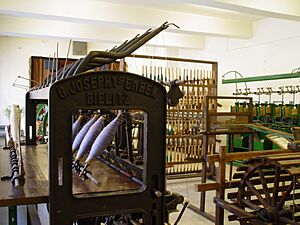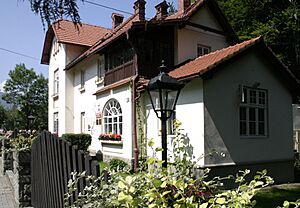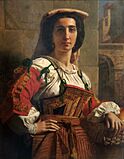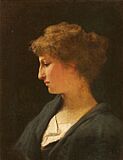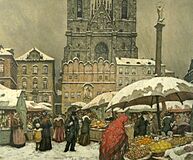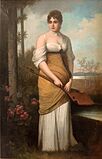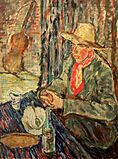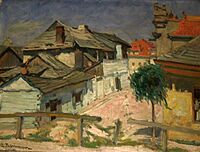Bielsko-Biała Museum and Castle facts for kids
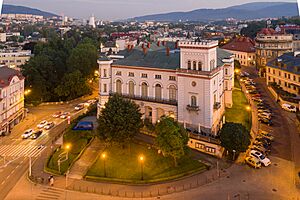
The Bielsko-Biała Museum, also known as the Castle of the Sułkowski Princes (Polish: Zamek książąt Sułkowskich), is a cool place to visit in the city of Bielsko-Biała, Poland. It's located inside the historic Bielsko Castle. This museum also has three other special locations that opened in the 1970s: the Julian Fałat Museum, the Museum of Technology and Textile Industry, and the Weaver's House Museum.
Contents
History of the Bielsko-Biała Museum
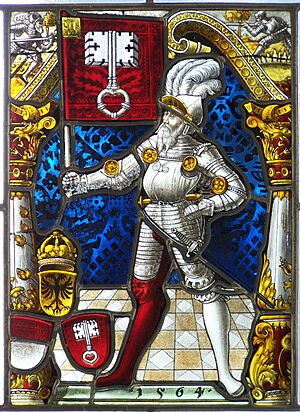
The Bielsko-Biała Museum, with its main home in the old Bielsko Castle, keeps alive traditions that started over 100 years ago. Back then, in the early 1900s, the local governments of Bielsko and Biała decided to create two separate museums.
How the Museums Started
The older museum, called the Biała Municipal Museum, began thanks to a teacher named Erwin Hanslik. The city council officially approved it on December 19, 1902. Around the same time, in nearby Bielsko, a similar idea came from a pastor named Arthur Schmidt. In 1903, people in Bielsko worked hard to collect interesting old items for a museum. They even showed off these items in June 1903 at a local shooting gallery. A few months later, the Bielsko City Council also decided to create a Municipal Museum.
Opening and Changes Over Time
The Biała Museum first opened its doors on December 3, 1904, inside the City Hall. It stayed there until 1920, when it closed for a while. Its exhibits were stored away. The museum reopened in 1932 in the basement of the building and stayed open until World War II began.
The Bielsko Museum opened to the public on February 25, 1906, in the Old Town Hall. It stayed open until 1941. Between the two World Wars, the museum grew a lot thanks to its curator, Edward Schnack. It became one of the biggest regional museums in Poland!
In 1941, during World War II, the Nazi authorities combined the two city museums into one, called the Heimatmuseum. It was located in Biała until the war ended.
The Museum Today
After World War II, in 1945, people decided to bring the museum back to life. The Municipal Museum in Bielsko reopened on February 14, 1947. Since the 1970s, it has added several special branches:
- The Julian Fałat Museum (opened in 1973)
- The Museum of Technology and Textile Industry (opened in 1979)
- The Weaver's House Museum (opened in 1992)
Since 2001, the main museum has been known as the Bielsko-Biała Museum. In 2013, its name changed again to the Bielsko-Biała Historical Museum.
The Castle: A Historic Home
Standing tall in the center of Bielsko-Biała, the Castle is the oldest and largest important building in the old part of the city. A legend says that long ago, there was a hideout for robbers here who attacked traveling merchants. Prince Casimir of Opole, from the Piast family, is said to have defeated the robbers and built a hunting palace in its place. Over time, this palace grew into the amazing castle we see today, and the city of Bielsko grew up around it.
Castle's Early Days
The oldest parts of the Castle date back to the 1300s. For hundreds of years, the Castle slowly changed and grew. It was a city castle, meaning it was part of Bielsko's defenses from the very beginning. It was the strongest part of the city's walls.
For a long time, it was a border stronghold. It guarded the borders of different duchies (small states ruled by dukes). Later, it protected the borders between the Czech and Polish states, and then between Austria and Poland.
From Fortress to Home
After the late 1500s, the Castle's role as a defense building became less important. It slowly changed into a fancy home for noblemen. The way the castle looks now is mostly from a big rebuilding project in the late 1800s. This project completely changed its old style.
From 1899 to 1973, there used to be a row of shops in front of the eastern part of the Castle. These shops were taken down to make Zamkowa Street wider.
Who Owned the Castle?
The Piast family, who ruled the Cieszyn Duchy, lived in this Castle for over 200 years. From 1572, it became the main center for the independent Bielsko state. This state was ruled by important noble families like the Promnitzes, Schaffgotsches, Sunneghs, Solmses, and Haugwitzes.
In 1752, the Bielsko state became a duchy and was taken over by the Sułkowski family. The Bielsko Duchy existed until 1849. After World War II, the Polish government took over the Castle. Since 1983, the Bielsko-Biała Museum has been the only user of the Castle.
Permanent Exhibition Inside the Castle
The main exhibition in the Castle is on the first floor. You enter through a beautiful 19th-century hallway.
In the west part of the building, you'll find a hunting room and an armory filled with old weapons. Two other rooms show art from the 1400s to the 1600s. Next to these are a fancy rococo concert hall and a cozy Biedermeier room.
The east part of the Castle has a gallery of paintings and graphic art from the 1800s and 1900s. The rooms in the north part of the building tell the story of the city and the Castle. They also show the traditions of craftsmen from old Bielsko and Biała.
The art gallery in the east wing displays paintings from the 1800s, including realistic art and works from the "Young Poland" movement. You'll also see art by artists connected to Bielsko-Biała from different time periods. Along the hallway facing the courtyard, there's a collection of graphic art from the early 1900s and portraits of people from Bielsko and Biała from the 1800s and 1900s.
On the ground floor of the Castle, there are three other rooms that host special temporary exhibitions that change from time to time.
Museum of Technology and Textile Industry
This museum helps keep alive the history of the wool industry in Bielsko-Biała. It collects machines, tools, and documents related to making textiles. The exhibits are in four rooms, each showing a different part of an old textile factory:
- The first room shows machines for preparing the wool.
- The second room is like a weaving mill.
- The third room shows how fabrics were finished.
- There's also a separate area with machines for making hats.
The museum also has exhibits about the history of the Bielsko-Biała fire brigade and the city's water supply system. You can also see a small printing office and a "museum granary" where old household items, radio sets, typewriters, and more are stored. Old lathes, drilling machines, and locksmith tools remind visitors of the city's history in metal processing.
The Weaver's House Museum
The Weaver's House Museum shows what the inside of a weaver's home and workshop looked like. This was the home of a guild master (a highly skilled craftsman). The museum tries to show how people lived and worked around the late 1800s and early 1900s.
A hallway divides the house into two main parts: the workshop is on the left as you enter, and the living areas (with a kitchen and a bedroom) are on the right.
The Weaver's House is a special example of an old wooden town house. It's a unique way to see how a craftsman worked, especially when guilds were very powerful.
Julian Fałat's Villa Museum
The museum dedicated to Julian Fałat is in Bystra Śląska. It's located in the artist's historic home, known as “Fałatówka.” Visitors can learn about his art and some details of his life. This is where the artist lived after he retired from being the head of the Cracow Academy of Fine Arts.
The exhibition displays his oil paintings and watercolors. You can see:
- Self-portraits (pictures of himself)
- Portraits of his family and friends
- Landscapes from his many travels
- Works related to hunting
The museum also has old documents about his life, art, and how he helped society. These include his school certificates, photos of him with family and friends, diplomas, awards, letters, and souvenirs from his travels around the world.
Gallery
- Museum collections
-
Study of a Woman by the Window, Jacek Malczewski
See also
- Bielsko-Biała
- List of castles in Poland


